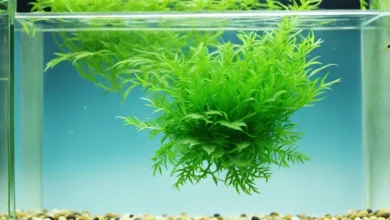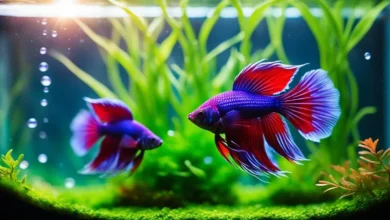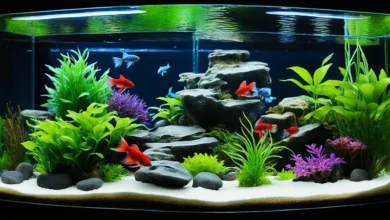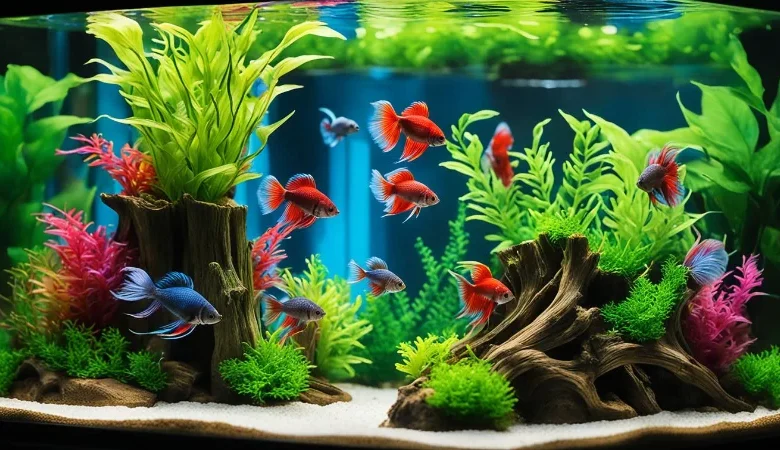
Have you ever thought about adding a snail to your Betta fish tank? It might seem surprising, given Betta fish’s aggressive nature, but some Bettas enjoy having tank mates. This can make watching your fish even more enjoyable. But why are snails often a good choice for Betta fish tanks?
Selecting the right companions is key in a Betta fish and snail community tank. Bettas can be territorial, so choosing compatible tank mates is crucial. Sns are excellent because they thrive in the same water conditions as Bettas and pose no threat. Plus, snails help keep the tank clean by eating algae, contributing to a healthier environment
When setting up a tank, ensure it’s at least 5 gallons. This space is essential for a happy Betta. Adding a snail not only gives your Betta a companion but also helps maintain a clean environment by eating leftover food and assisting with waste management. Together, they create a healthy and pleasant aquarium for both fish and snails.
Understanding Betta Fish Behavior
To keep your aquarium peaceful, betta fish behavior must be understood. These fish, known as Siamese fighting fish, have special traits from their natural homes and unique personalities.
Natural Habitat
Betta fish come from Southeast Asia’s flood plains, where they’ve learned to live in low waters. Their natural environment is key to their territorial nature. It includes warm, slow-moving waters with plenty of plants and hiding places.
Territorial Nature
Siamese fighting fish are named for their territorial habits. They need space and often act aggressively to protect it. Sometimes, they surprise us with how they behave, like when they harm other fish instead of being friends, which is what happened to platies in your example.
Betta fish can sometimes show aggression, particularly when fasting or stressed. It’s essential to keep an eye on their interactions with other tank residents.
Individual Temperaments
Each Betta has its unique character, contributing to Betta’s individuality. Some are very aggressive, while others are quite calm. Understanding this helps you determine if a Betta can live with others or needs to be alone. For example, one Betta might leave a snail friend safe, but another could hurt the snail.
In online forums, many people share their experiences about keeping Bettas with snails. They have observed that Bettas can get used to their tank mates over time, highlighting the importance of monitoring and making adjustments based on behavior.
To avoid conflicts, it’s wise to have plans in place:
- Separate tank: Useful for reducing stress when introducing new fish.
- Hiding spots: Provide places for snails to retreat.
- Tank size: Ensure enough space for all inhabitants.
Knowing about Betta’s individuality and typical behaviors is key to maintaining a friendly aquarium. By recognizing and adjusting to their behaviors, you can create a tank where everyone thrives.
The Role of Snails in an Aquarium
Adding snails to your betta tank does more than make it look nice. They help keep the balance of the water just right. Snails are great for cleaning and they also keep the tank’s health up.

Algae Control
Snails shine as great cleaners in betta tanks because they love to eat algae. By doing this, they stop algae from growing too much. This keeps your tank cleaner and your fish happier.
Waste Management
They’re also awesome at cleaning up leftovers and dead plants. Snails turn this waste into something useful for the tank. This helps keep the water cleaner and the whole tank healthier.
Tank Enrichment
But, snails are not just workers in the tank; they add beauty too. They bring color and life. Their movements add fun to watching the tank. Plus, they help to make the water’s oxygen levels just right, which is key for a healthy tank.
Can Betta Fish and Snails Coexist?
To successfully house a Betta fish with a snail, consider the Betta’s personality and tank setup. Male Bettas can be territorial and might not welcome a snail, but some are more tolerant.
Other fish like Catfish, Plecos, Corydoras, and Loaches, which stay at the bottom, often get along well with Bettas. Snails, with their protective shells, are also a good choice.
Here are a few tips to ensure harmony in your tank:
- Tank size: A 10-gallon tank is a good start for a Betta and some Mystery Snails, providing enough room for both.
- Water quality: Too many snails can make the water dirty, so clean the tank well and change the water often to keep everyone healthy.
- Safety: Some Bettas might try to eat tiny shrimp, and snails can get hurt if a Betta is too rough. Make sure the tank has enough space and places for snails to hide.
Creating a home where a Betta and a snail can live together takes work. You need to watch and care for their home daily. This is the key to a happy tank.
Best Snail Types for Betta Fish Tanks
Choosing the right snail types is crucial for your betta tank. They must live well together and help the tank stay healthy. Mystery Snails and Nerite Snails are top choices. They are friendly and do a great job.
Mystery Snails
Mystery Snails are popular for betta tanks. They are calm and clean up by eating food and algae. This keeps the tank tidy. They also don’t have babies on their own, so you won’t end up with too many.
Nerite Snails
Nerite Snails also make a great fit. They have beautiful shells that make your tank look good. These snails love eating algae, which is good for your bettas. They won’t have babies in your tank, which is a big plus.
Both types need enough room, clean water, and the right temperature. Picking these snails will help your tank be peaceful and healthy. Your betta fish and snails will enjoy living together.
Setting Up a Betta Fish and Snail Tank
To make a good home for betta fish and snails, start with the right tank setup. Each one must find the tank’s conditions good for living together happily.
Tank Size
Choose the right size tank first. A 5-gallon tank is the smallest for a betta. If you want to add snails and friends, think about a 10-gallon tank or bigger. More space makes it easier for everyone to live together well.
Water Conditions
Keep the water right for bettas and snails. Betta fish like it warm, between 76-82°F, with a pH of around 7.0. Clean and stable water is key. Use tools like a heater, sponge filter, and air stone to keep it in good shape.
Introduction Process
How you introduce your pets is crucial. Start by matching the tank’s water to the bettas’ temperature. Watch how the bettas and snails first meet. Making this step slow and careful helps them get used to each other, avoiding stress later.
Benefits of Having Snails with Betta Fish
Adding snails to a betta tank boosts the ecosystem. They act as natural cleaners. Snails help manage algae and break down waste. This keeps the tank clean and healthy for all inhabitants. Their role is key in maintaining a pristine environment.
Cleaner Environment
Snails are great at keeping algae under control. They eat the green stuff off tank surfaces and decorations. This helps the ecosystem stay healthy. They also eat leftover fish food and decomposing plants. This keeps the water clean and of good quality.
Added Visual Appeal
Snails don’t just clean, they make the tank look better. They come in various shapes and colors. For example, Mystery Snails have bright shells, and Nerite Snails have cool patterns. They make your tank a fun place to look at. And they help your betta fish stay active and healthy without any harm.
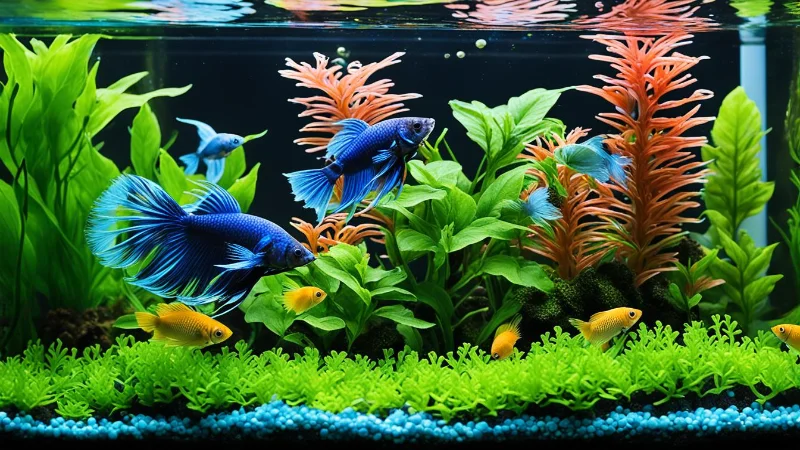
Snails also help to oxygenate the tank’s substrate. More oxygen in the water means a better home for your fish. By choosing the right types of snails and taking care of them well, your tank will be a beautiful and healthy space for your bettas and snails to thrive together.
Challenges to Watch Out For
Adding snails to your betta tank can be rewarding. But, it’s important to watch out for some challenges. These include the bettas’ aggressive behavior, too many snails, and keeping the water clean. Now, let’s talk about these difficulties.
Aggressive Betta Behavior
Bettas can get aggressive, especially when snails join. Some bettas don’t like to share their space. They might hurt snails, which is why you have to watch them. Make sure your betta and its new snail friends get along.
Snail Overpopulation
Some snails reproduce fast, and too many can be a problem. This can make the tank’s environment stressed and the water dirty. If you have snails like mystery snails, take care not to let them overbreed.
Maintaining Water Quality
More creatures in the tank mean more work to keep the water clean. With both bettas and snails, you need to do regular water changes. Also, keep an eye on the water quality and be sure both snails and bettas have what they need.
In an online chat, 8 people shared how to deal with these issues for a happy tank. They said it’s important to manage the Betta’s fighting, the snail numbers, and the cleaning.
This advice highlights the key factors in creating a harmonious aquarium environment.
Conclusion
Creating a Betta fish tank with snails requires careful planning, as their interaction can be fascinating but challenging. Understanding the behavior and needs of both Betta fish and snails is essential. Some Betta species, like Betta Rainbow, may initially dislike snails, causing potential issues.
However, with patience and the right approach, many Betta fish can adapt to snails, particularly ramshorn snails. Maintaining optimal water conditions and providing hiding spots with decorations and plants can reduce conflicts and make Betta fish feel more at home.
Snails, such as Mystery Snails and Nerite Snails, are great for beginners and help keep the tank clean by eating algae and managing waste. They add liveliness and interest to the tank, benefiting both the fish and the overall environment. Ensure ample space and monitor water conditions closely to create a harmonious and balanced habitat for both Betta fish and snails.1 With care and attention, they can coexist successfully, making your tank more dynamic and enjoyable.
